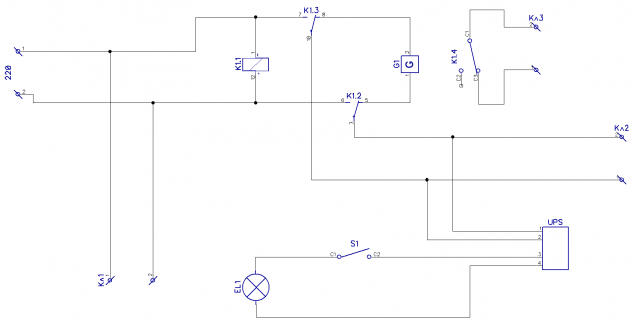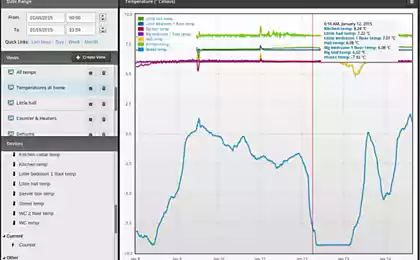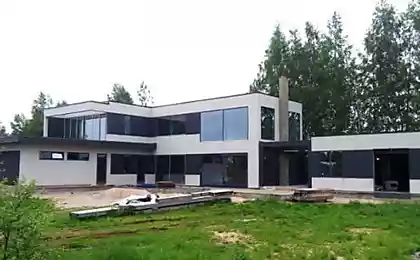508
The supply of private homes is a low - budget solution
In this article I want to begin by describing the concept of the smart home in my understanding and to consider some aspects of its implementation. Immediately say, that I almost do not see the application of the concept of "Smart home" to the apartment, as there is virtually no system that requires automation. Quite another matter — a private home. It contains many systems that can and should be automated — from water supply to garden lighting. So, my definition. Smart house is a set of automatic systems that operate with minimal involvement of its inhabitants, while ensuring maximum comfort, safety and energy saving. The implementation should be simple and affordable.
I'll start with the implementation of the supply house.

Backup power supply Domov contrast to apartments, the house is much stronger dependent on the availability of electricity, because in its absence, automatically deprived of virtually all their systems — lighting, heating, ventilation, hot water, and often even of water, if you use the pump station. Therefore, within the comfort of smart home it is necessary to provide backup power supply. The simplest solution is the offline generator. But it should be more correctly connected to the resumption of power supply do not burned, to choose his power so as not to overload and to decide on its launch. Of course, you can install a power plant with a capacity of 10 kW, with automatic start and with the schemes of coordination with the grid, but its price is prohibitive. That and to install it is not so simple. Well, the question remains, when to start immediately after power failure, after half an hour or manually. After walking with a flashlight waiting to run as it is not very comfortable, and instant start-up is often uncomfortable, especially at night or in 15-minute trip. So the easiest option is expensive and not very comfortable. This has led to the search for more sustainable solutions.
Describe briefly the main idea. It consists of several solutions:
Details realizaciis still, a blackout — it is an extraordinary situation, it makes no sense to spend money on a fully Autonomous system. Therefore, we divide consumers into groups. This coverage, critical of the system (boiler, pump), non-critical systems (refrigerator, ventilation, TV). That gives the most discomfort during a power outage? Usually it is the lack of lighting. Without lighting it is difficult to do, well, it consumes a little. Therefore, its reserve in the first place, via UPS. A specific model must be selected on the basis of several conditions — the number and type of lamps, type and capacity of the battery. In most cases, the conventional computer UPS, $200. It is connected to the flap, in the open light lines. Time battery life should be at least 30 minutes to cover short interruptions and allow time to run the generator, if necessary. Sound the alarm you wish to disable, not to Wake up the house at night.
The next issue is the choice of power generator. Typically 2500 watts is more than enough. And this is a common consumer model, worth about $400. This is enough to power the pumps of the boiler and wells, lighting, fridge and computer. The power of all of the batteries, by analogy with light, is extremely profitable. Firstly — you need the high output of inverter, the second high capacity battery and the high price of their replacement, in the third, the inverter should produce the correct sine wave, because its form is sensitive to some engines and modulated burner. The generator produces a clean sine wave, offline at least 15 hours on one filling, cheap. Also, it often comes with the starter and its own battery that allows you to implement AutoPlay.
Next — wiring the redundant power supply from the generator. It can be connected to the pumps and the boiler. You must provide at least one outlet in every room. This will allow you to connect optional other household appliances.
Well, the last connection.

Connection scheme of backup power systems.
In the diagram below:
EL1 — lighting in the house
KL1 terminal connection not reserved sockets
Кл2 — terminal connection sockets reserved
Кл3 terminal included in the gap of the spark generator.
K1 — relay control contact group K1.2, K1.3, K1.4
G — generator
UPS — uninterruptible power supply
When there is voltage, the relay coil is energized and power is supplied directly to the network. In the event of a power failure, the contacts will move to the original position indicated on the diagram, and connects to the network generator. Lighting will continue to eat for some time from the UPS battery. If necessary, the generator can run, which will provide power backup lighting and sockets, connected to the terminal Кл2. When external power is restored, the relay K1 will work off the generator from the network and breaking the ignition circuit of the generator, thereby drowning it. The system will return to its original state. Connection diagram is only a demonstration of ideas, not a concept.
In the end, the cost of the entire system is about $600 + wiring. But in some cases, you can use the existing wiring if it is properly placed on the plate.
Posleslovie article describes the basic scheme. It at desire can and should be improved. Especially when there is the possibility of integration with remote management, monitoring and others. At least in the future you can add an alert about a power outage, remote start and turn off the generator, etc. Also, along with the lighting can provide backup power through UPS, alarm system, router and server, but usually this is not required. As they are most often equipped with their own backup power sources.
It is enough to turn them into a socket connected to a power line from the generator. Also, I had not considered the connection of solar panels and wind turbines. It is expensive and ill-suited for backup power. They give low power for the entire service life, and for back-up power need relatively high power for a short period — a few dozen hours a year.
Source: /users/42
I'll start with the implementation of the supply house.

Backup power supply Domov contrast to apartments, the house is much stronger dependent on the availability of electricity, because in its absence, automatically deprived of virtually all their systems — lighting, heating, ventilation, hot water, and often even of water, if you use the pump station. Therefore, within the comfort of smart home it is necessary to provide backup power supply. The simplest solution is the offline generator. But it should be more correctly connected to the resumption of power supply do not burned, to choose his power so as not to overload and to decide on its launch. Of course, you can install a power plant with a capacity of 10 kW, with automatic start and with the schemes of coordination with the grid, but its price is prohibitive. That and to install it is not so simple. Well, the question remains, when to start immediately after power failure, after half an hour or manually. After walking with a flashlight waiting to run as it is not very comfortable, and instant start-up is often uncomfortable, especially at night or in 15-minute trip. So the easiest option is expensive and not very comfortable. This has led to the search for more sustainable solutions.
Describe briefly the main idea. It consists of several solutions:
- The power of all house lighting via UPS. This will allow you to always have the lighting on for several hours, depending on battery, time of day, the number and type of included bulbs.
- The presence of additional wiring for sockets with backup power. This will provide backup power to the critical system generator minimum power. Without the need to disconnect all consumers from the outlets to avoid overloading the generator. Outlet it is advisable to make a different color so that they can be easily identified.
- A scheme which automatically connects the generator to the network, in case of its absence and disables the generator from the network when power supply is restored.
- Run the generator. It is possible to solve the choice — automatically, by timer, manually. I prefer to start manually.
- Automatic shutdown of the generator.
Details realizaciis still, a blackout — it is an extraordinary situation, it makes no sense to spend money on a fully Autonomous system. Therefore, we divide consumers into groups. This coverage, critical of the system (boiler, pump), non-critical systems (refrigerator, ventilation, TV). That gives the most discomfort during a power outage? Usually it is the lack of lighting. Without lighting it is difficult to do, well, it consumes a little. Therefore, its reserve in the first place, via UPS. A specific model must be selected on the basis of several conditions — the number and type of lamps, type and capacity of the battery. In most cases, the conventional computer UPS, $200. It is connected to the flap, in the open light lines. Time battery life should be at least 30 minutes to cover short interruptions and allow time to run the generator, if necessary. Sound the alarm you wish to disable, not to Wake up the house at night.
The next issue is the choice of power generator. Typically 2500 watts is more than enough. And this is a common consumer model, worth about $400. This is enough to power the pumps of the boiler and wells, lighting, fridge and computer. The power of all of the batteries, by analogy with light, is extremely profitable. Firstly — you need the high output of inverter, the second high capacity battery and the high price of their replacement, in the third, the inverter should produce the correct sine wave, because its form is sensitive to some engines and modulated burner. The generator produces a clean sine wave, offline at least 15 hours on one filling, cheap. Also, it often comes with the starter and its own battery that allows you to implement AutoPlay.
Next — wiring the redundant power supply from the generator. It can be connected to the pumps and the boiler. You must provide at least one outlet in every room. This will allow you to connect optional other household appliances.
Well, the last connection.

Connection scheme of backup power systems.
In the diagram below:
EL1 — lighting in the house
KL1 terminal connection not reserved sockets
Кл2 — terminal connection sockets reserved
Кл3 terminal included in the gap of the spark generator.
K1 — relay control contact group K1.2, K1.3, K1.4
G — generator
UPS — uninterruptible power supply
When there is voltage, the relay coil is energized and power is supplied directly to the network. In the event of a power failure, the contacts will move to the original position indicated on the diagram, and connects to the network generator. Lighting will continue to eat for some time from the UPS battery. If necessary, the generator can run, which will provide power backup lighting and sockets, connected to the terminal Кл2. When external power is restored, the relay K1 will work off the generator from the network and breaking the ignition circuit of the generator, thereby drowning it. The system will return to its original state. Connection diagram is only a demonstration of ideas, not a concept.
In the end, the cost of the entire system is about $600 + wiring. But in some cases, you can use the existing wiring if it is properly placed on the plate.
Posleslovie article describes the basic scheme. It at desire can and should be improved. Especially when there is the possibility of integration with remote management, monitoring and others. At least in the future you can add an alert about a power outage, remote start and turn off the generator, etc. Also, along with the lighting can provide backup power through UPS, alarm system, router and server, but usually this is not required. As they are most often equipped with their own backup power sources.
It is enough to turn them into a socket connected to a power line from the generator. Also, I had not considered the connection of solar panels and wind turbines. It is expensive and ill-suited for backup power. They give low power for the entire service life, and for back-up power need relatively high power for a short period — a few dozen hours a year.
Source: /users/42























